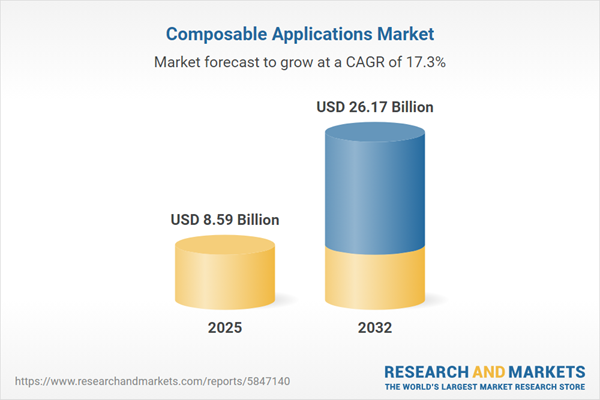Speak directly to the analyst to clarify any post sales queries you may have.
The composable applications market empowers organizations to reconfigure IT architectures with modular tools, strengthening adaptability and maintaining operational resilience as technology, compliance, and business requirements evolve. Senior leaders increasingly turn to composable solutions to keep pace with complex, fast-moving demands in modern enterprise environments.
Market Snapshot: Composable Applications Market Growth & Dynamics
The composable applications market demonstrates robust growth, expanding from USD 7.31 billion in 2024 to USD 8.59 billion by 2025 and projected to reach USD 26.17 billion by 2032. This strong trajectory reflects a compound annual growth rate of 17.28%. The primary drivers include the rising need for adaptable digital infrastructures and intensified urgency for agile compliance and risk mitigation, especially as organizations invest in scalable solutions that support ongoing transformation. Enterprises across sectors embrace composable platforms to enable continuous value creation, align with regulatory expectations, and foster new digital initiatives within fast-changing markets.
Scope & Segmentation of the Composable Applications Market
- End User Industry: BFSI and healthcare adopt modular architectures for strong regulatory compliance and effective risk management. Government and defense prioritize secure IT ecosystems suitable for critical, sensitive missions. Manufacturing and telecommunications industries require platforms capable of instant scalability to ensure operational efficiency and optimize customer experience. Retail and e-commerce sectors leverage modular solutions to accommodate transaction fluctuations and respond swiftly to shifts in consumer preferences.
- Deployment Model: Cloud, hybrid, private, and public deployment models support seamless integration and flexibility for geographically dispersed operations. On-premises options focus on enhanced data sovereignty and mitigating latency, while hybrid or multi-cloud approaches deliver adaptable, customizable environments for diversified operational scenarios.
- Component: Modular software frameworks and advanced integration tools connect legacy and modern systems with minimal disruption. Professional services—consulting, implementation, and technical support—are essential to align technical investments and realize successful deployments, particularly for organizations facing complex integration challenges.
- Organization Size: Large enterprises leverage composable solutions to reinforce IT control, cross-functional collaboration, and long-term resilience. Small and mid-sized businesses rely on modular upgrades to streamline workflows, reduce technical debt, and sustain competitiveness in the digital landscape.
- Region: The Americas prioritize digital transformation and regulatory compliance in composable adoption. Asia-Pacific fast-tracks implementation for digital-first initiatives, enhancing agility across sectors. EMEA focuses on governance, data privacy, and regulatory consistency, while Middle East and Africa invest in composable integration to secure continuity and unlock new market opportunities.
- Leading Technology Providers: Microsoft, Oracle, SAP, Salesforce, Adobe, Intuit, ServiceNow, Workday, Shopify, and Pega Systems offer market-leading platforms and deliver consulting, integration, and support services to accelerate modernization efforts worldwide.
Composable Applications Market: Key Takeaways
- Modular IT frameworks give organizations greater flexibility, enabling rapid adaptation when compliance and business needs shift.
- Reusable software components facilitate effective collaboration, breaking down departmental silos and expediting project timelines for cross-functional teams.
- The integration of cloud-native capabilities and low-code/no-code development enhances innovation speed, optimizing transformation with minimal operational disruption.
- Strategic alliances with trusted technology leaders help enterprises mitigate risks and streamline decision-making in supply chains and system management.
- Comprehensive professional services are vital for regulated industries, ensuring composable deployments are efficient and meet sector-specific standards.
- Organizations tailor deployment models based on risk tolerance, operational priorities, and the need for scalable, secure infrastructures.
Tariff Impact: Navigating U.S. 2025 Tariffs
Forthcoming U.S. tariffs scheduled for 2025 are reshaping procurement and supply chain strategies in multiple sectors. Enterprises are responding by leveraging open-source components and modular procurement practices to secure operations and maintain compliance amid evolving trade regulations.
Methodology & Data Sources
This analysis uses insights from executive interviews, targeted industry surveys, and systematic market reviews. It is further informed by proprietary deployment data, academic research, and established models including PESTLE, SWOT, and Porter’s Five Forces, enabling a comprehensive and actionable assessment of the composable applications market.
Why This Report Matters
- Guides leadership teams in identifying valuable market segments and aligning technology investments with organizational objectives and evolving digital needs.
- Enables stakeholders to synchronize digital transformation and risk management strategies, supporting continuity and operational resilience despite regulatory shifts.
- Functions as a benchmark for measuring digital maturity and readiness, helping enterprises act proactively in dynamic technology environments.
Conclusion
Composable applications empower organizations to modernize IT infrastructures, adapting to shifting needs in a landscape of continual change. Actionable market intelligence supports strategic planning for resilient, long-term growth and operational success.
Additional Product Information:
- Purchase of this report includes 1 year online access with quarterly updates.
- This report can be updated on request. Please contact our Customer Experience team using the Ask a Question widget on our website.
Table of Contents
3. Executive Summary
4. Market Overview
7. Cumulative Impact of Artificial Intelligence 2025
Companies Mentioned
The companies profiled in this Composable Applications market report include:- Microsoft Corporation
- Oracle Corporation
- SAP SE
- Salesforce, Inc.
- Adobe, Inc.
- Intuit Inc.
- ServiceNow, Inc.
- Workday, Inc.
- Shopify, Inc.
- Pega Systems Inc.
Table Information
| Report Attribute | Details |
|---|---|
| No. of Pages | 189 |
| Published | October 2025 |
| Forecast Period | 2025 - 2032 |
| Estimated Market Value ( USD | $ 8.59 Billion |
| Forecasted Market Value ( USD | $ 26.17 Billion |
| Compound Annual Growth Rate | 17.2% |
| Regions Covered | Global |
| No. of Companies Mentioned | 11 |









